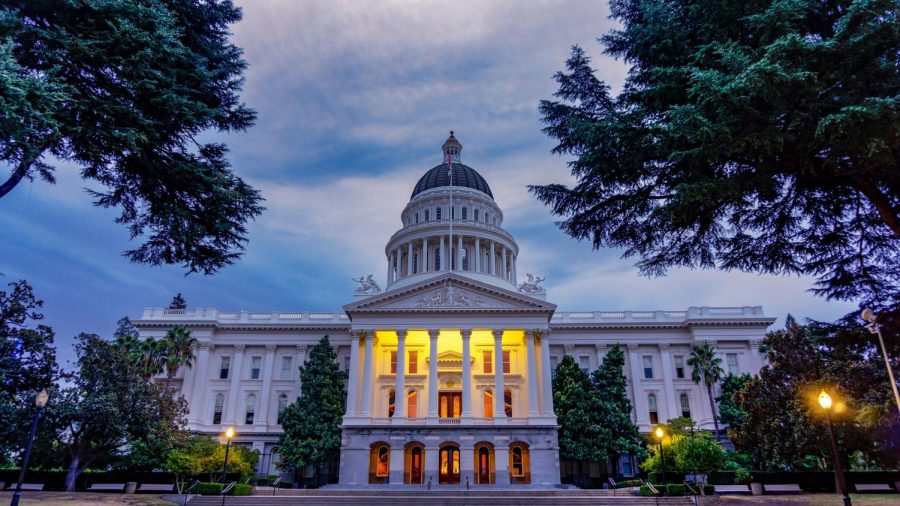Sacramento’s Out of the Darkness Community walk to fight suicide
Sac State volunteer sheds light on the university’s involvement
Jeff Turner – CC BY 2.0
The California State Capitol in Sacramento on Oct. 1, 2015. The Capitol will host Sacramento’s Out of Darkness Walk Saturday, Sept. 29, 2018, as a fundraiser for the American Foundation for Suicide Prevention.
September 28, 2018
Over a thousand people are expected to participate in the annual Out of the Darkness Community Walks event hosted by the American Foundation for Suicide on Saturday.
Sacramento Out of the Darkness Walk is a fundraiser in support of suicide prevention programs, as well as supporting survivors of suicide and those who know people that died by suicide. The AFSP set their goal to reduce the annual suicide rate to 20 percent by 2025.
Sacramento State peer health educators and the student club National Alliance on Mental Illness club will be participating in the walk, which begins at 9 a.m. at the State Capitol located at 1315 10th St.
Alexandria Byrd, Student Health and Counseling Services admin support assistant, volunteers at the event and discussed how she connects Sacramento State with the walk to help prevent suicide.
Q: Do you think college students are more susceptible to suicide due to the stressors and work-life balance they have to maintain?
A: “The biggest things that impact a student’s education are sleep, anxiety and stress. This alone can lead to a crisis point where the student becomes overwhelmed and may have suicidal ideations.”
Q: How has the event Sacramento Out of the Darkness Walk saved lives by raising awareness?
A: ”It’s made it so that they can actually either cope with a loss that they have had or encourage them to go and get the assistance that they need.”
Q: What’s the average turnout in people who show up to raise awareness?
A: “The campus walk that was held this past year in April had a turnout of about 1,800 people, and this past year the city walk had about 2,500 people help raise awareness by taking part in the walk.”
Q: Do you think in today’s day and time, with suicide having less of a stigma, we are more equipped to talk about it?
A: “The less stigma there is around it, the more likely people will be able to get the help they need. There is always this stigma of, ‘I can’t talk about it, I’m not supposed to talk about it.’ Why can’t we treat it the same as when we have a headache, or when we have the flu?”
Q: Where does the money raised from the event go, and how does it prevent suicide?
A: “The money raised goes towards the American Foundation for Suicide Prevention educational program funding. Here, they are able to work with schools and assist with training. It’s just like being ready with CPR. I think everyone should be able to get trained, have that available, and have that be a regular part of us knowing how to react.”
Q: Do you think it’s easier to show support to those struggling with thoughts of suicide after being so personally connected to it?
A: “Most people have some sort of connection to suicide in some sense. It may not be directly just them, but everyone has a friend or knows someone who has struggled. For me personally, volunteering with the walk and getting more involved with it allowed me to grow through the American Foundation for Suicide Prevention program. When I first moved to Sacramento, I was dealing with a lot of stress. I had a partner attempt suicide and I was the first responder. It caused me a lot of stress and self-blame because at one point he accused me of being to blame for his attempt.”
Q: What are the statistics of people who die by suicide each year, and what age group is most highly impacted?
A: “Over 800,000 people die by suicide each year, according to a 2014 study conducted by the World Health Organization. The age group of that most highly affected is between 10 and 44 years of age. It’s the second leading cause of death. For every person lost to suicide, 25 more people have attempted.”
Q: Aside from talking about it, what sort of action do you recommend one takes in the form of self-care?
A: “Do what you need to do to make sure you’re getting the balance, the support, the regular care for yourself, on top of everything else that you’re doing in your life. We’re students, we’re employees, we all have these roles, but a lot of times we forget that we need to take care of ourselves.”

































































































































